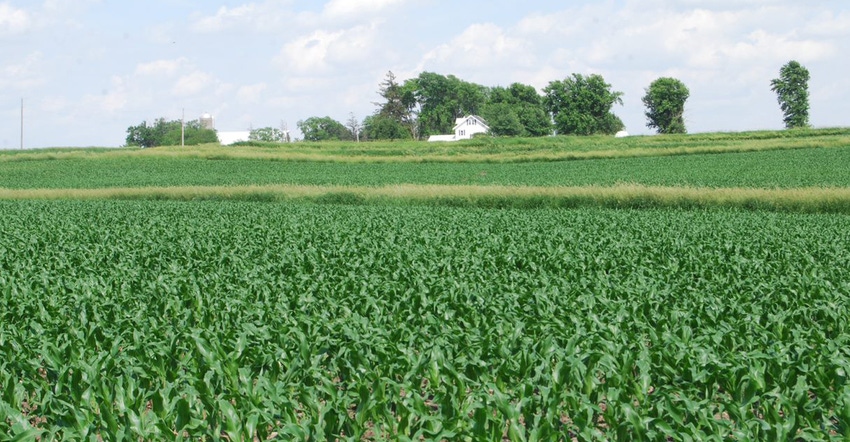May 21, 2019

Wetter and cooler-than-normal soils this spring mean many early-season diseases will have the perfect environment to thrive. As temperatures warm up, university researchers have predicted foliar disease threats could be more widespread in 2019.
If 2018 is any indication of potential disease risks for Iowa corn and soybeans, growers will need to watch their fields even more closely this year and apply fungicides when necessary, says Syngenta field agronomist Dean Grossnickle. The same diseases, like northern corn leaf blight, for example, will likely pop up again and threaten yield as the inoculum and host are already present. All that’s needed is the right environment for disease to infect crops this year.
3 top yield robbers
In 2018, Iowa corn growers saw an uptick in gray leaf spot, northern corn leaf blight and tar spot. While some hybrids are less susceptible to gray leaf spot and northern corn leaf blight, no hybrids have been recognized to have known resistance to tar spot.
Growers tempted to take a wait-and-see approach to save money on fungicides should be aware that when symptoms show, yield and profit loss has already occurred. “While it’s likely that not every acre had all three diseases in 2018, all three can devour yields if left unchecked. With an incubation period anywhere from 10 to 40 days, we recommend growers apply fungicides preventively to protect yield,” Grossnickle says.
“Because gray leaf spot and northern corn leaf blight typically don’t show up until later in the season, we’ve found you get the most bang for your buck when you apply Trivapro fungicide at that R1/VT timing or just before tasseling. The longer-lasting residual control will enable the crop to finish well and reach maximum yield potential,” he says.
Watch out for tar spot
Tar spot is a relatively new disease that has gained a foothold in Iowa. It overwinters, and only a small amount of spores need to survive to re-infect a field the following season, Grossnickle says. “Tar spot is aggressive, if a field had tar spot last year, we recommend growers plan to spray for it. If a neighbor has it or if it was in a county or state nearby, growers may need to spray.”
Also consider the following when thinking about fungicide application for tar spot.
Overwintering spores. While only 20% to 25% of overwintering spores will survive, tar spot can produce millions of spores, so even just a few overwintering spores can cause severe damage.
Long latent period. Corn can be infected 14 days or more before visible symptoms appear, so preventive control is crucial to keep this disease from causing costly damage.
Depending on risk level and disease pressure, growers should consider fungicide applications to protect their corn, he adds. For tar spot particularly, if conditions for heavy pressure exist early, consider treating corn with Trivapro during the V4 to V8 window, and make a second application at R1 growth stage to protect yield through harvest. For less severe cases, a single application at R1 should provide the protection needed.
4 top soybean yield stealers
In soybeans, keep a close eye on frogeye leaf spot, sudden death syndrome and brown spot. And white mold, while not widespread, should not be ignored.
In a season like this one, the likelihood of SDS will be much higher. Unfortunately, growers don’t have access to any foliar treatments that will help when symptoms manifest later this summer. You have to think about protecting the plant against early-season infection at the root level, where both soybean cyst nematode and SDS work in tandem to attack the roots.
While it won’t be available this season, a new seed treatment containing Adepidyn fungicide will be available for 2020. It will be marketed as Saltro fungicide upon EPA registration. “We’ve seen control of SDS and nematodes without causing additional early-season plant stress with Adepidyn, and we’re excited to make it available to growers in 2020,” Grossnickle says.
Battling white mold in beans
For this season, growers who have battled white mold know the damage it can do. Grossnickle advises keeping these factors in mind when dealing with white mold:
Scout just before flowering. Also scout whenever conditions are ripe for disease development:
July rain between ¾ of an inch and 4 inches
average July temperatures of less than 67 degrees F
Apply preventive fungicide. If conditions are right for white mold development, a preventive fungicide should be applied.
“Our latest fungicide innovation for soybeans, Miravis Neo, will help growers combat white mold early in the season,” Grossnickle says. It also helps control more widespread diseases like frogeye leaf spot and brown spot.
“Beyond excellent disease control, Miravis Neo is different than other soybean fungicides on the market,” he says. “It has three active ingredients: azoxystrobin, propiconazole and our latest and most powerful SDHI, Adepidyn fungicide. Two of those active ingredients provide plant-health benefits in addition to disease control, and the difference will be something growers can’t miss.”
With luck, the predictions will be wrong and disease pressure will be low. But if they prove accurate, growers have plenty of tools to help protect their crops and potential profitability this year, he adds.
Source: Syngenta, which is responsible for information provided and is wholly owned by the source. Informa Business Media and its subsidiaries aren’t responsible for any content contained in this information asset.
You May Also Like




